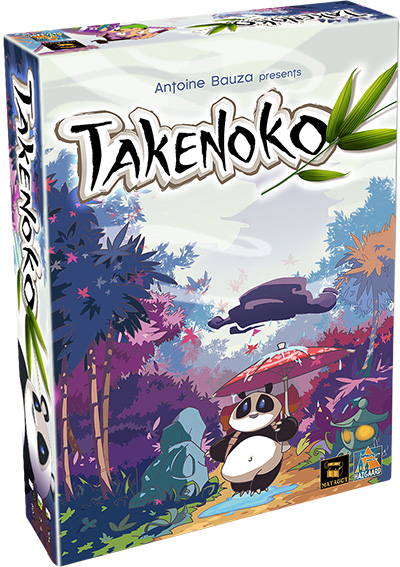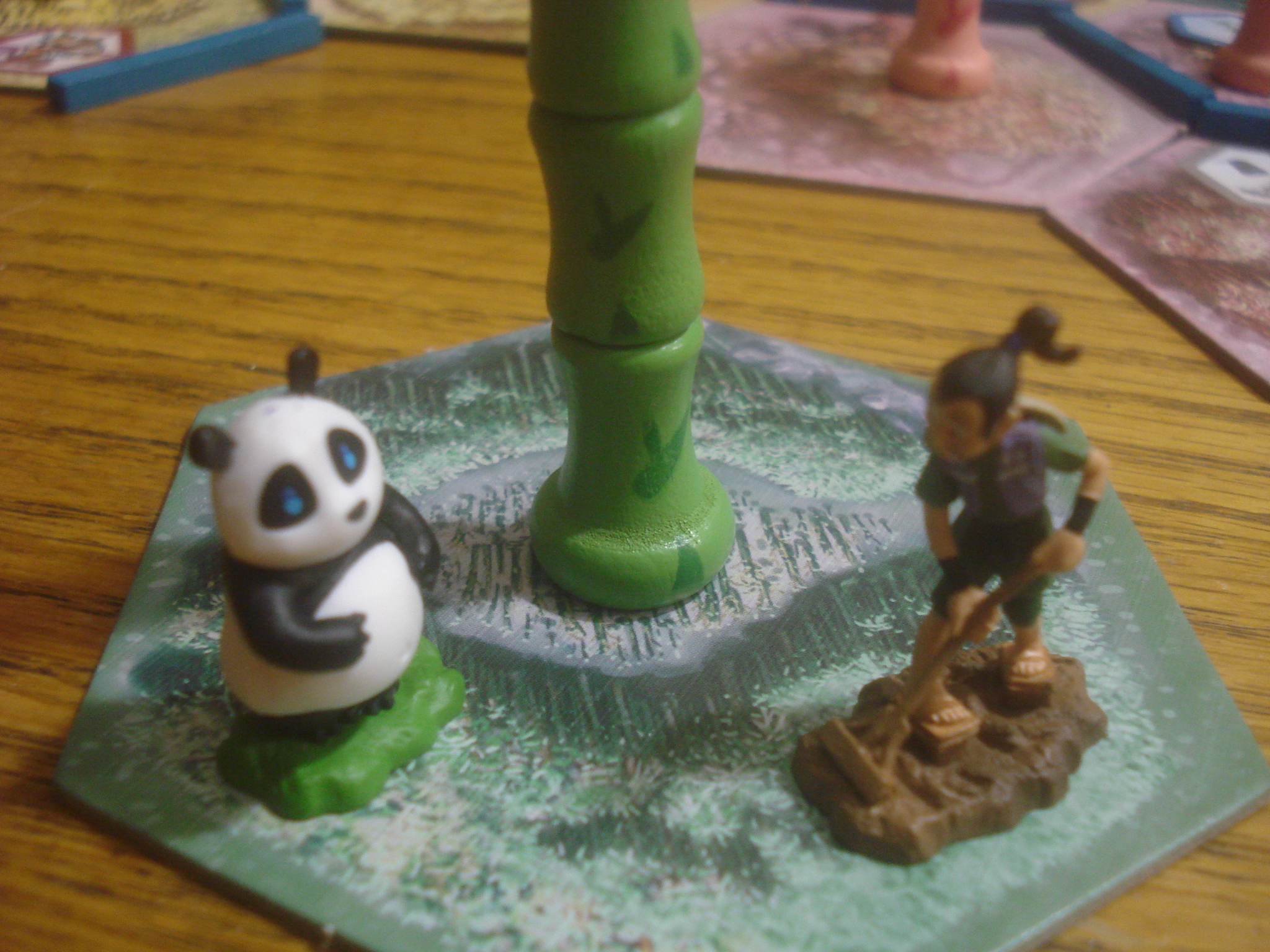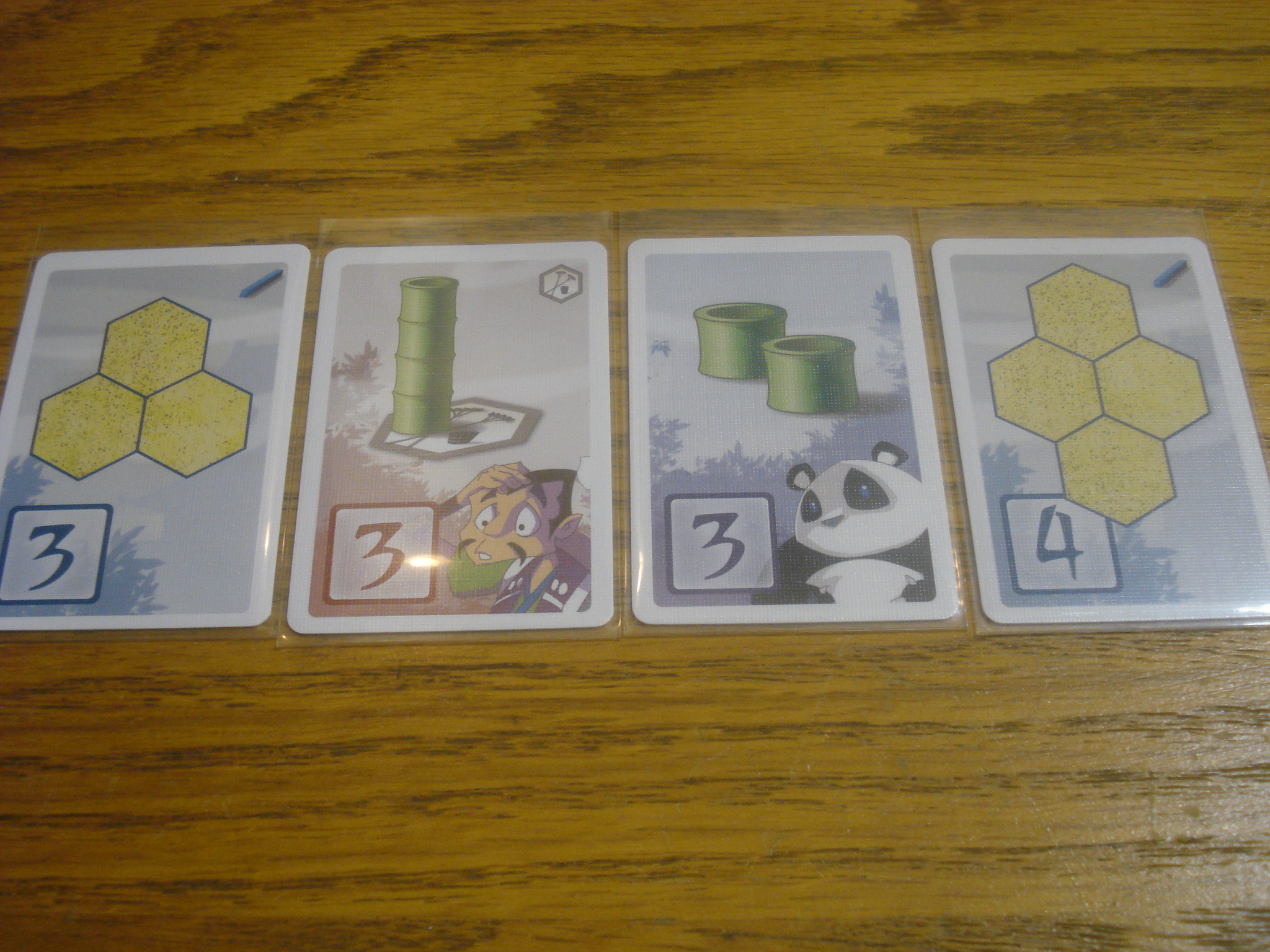| Publisher | Asmodee Editions |
| Design Credits | Antoine Bauza |
| Art Credits | Nicolas Fructus, Joël Van Aerde, Yuio, Julien Jeanroy-Bertrand |
| Translation | Eric Franklin, Michael Kröhnert, Humphrey Clerx |
| Game Contents | 28 hexagonal plots in three colors, 90 bamboo sections in three colors (36 green, 30 yellow, and 24 pink), 20 irrigation channels, nine improvement chits, 46 objective cards, four player boards, eight action chips, one weather die, one panda figure, one gardener figure, rule booklet |
| Guidelines | Panda-feeding, bamboo-growing strategy game |
| MSRP | $49.99 |
| Reviewer | Andy Vetromile |
Are international relations really worth all this trouble? To the emperor, the warlords, all those folks, maybe. To the poor guy who has to not only plant and tend a garden full of bamboo shoots for China’s gift of a giant panda, but keep the animal itself fed and not let it eat everything in the garden all at once, the occasional war might sound a bit relaxing. Oh, well, this is everyone’s chance to do their part for world peace. This is Takenoko.
The object of the game is to score the most points.
Two to four gardeners look after the imperial gardens and their sole inhabitant, the panda. The garden and its accompanying bamboo shoots come in three colors, pink, green, and yellow, and players take turns trying to grow the crop and feed the animal. Each turn a player rolls the specialty die to determine the weather and the benefit he gets from the conditions. He might get an extra action, for example, or receive a chit that helps him plant and cultivate, or move the panda to another part of the fields. Then he takes two actions. This may be to collect an irrigation canal, send the gardener to tend a garden section, or expand the playing area, among other things.
The garden is a series of colored hexagons connected to a central pond hex. Anything adjacent to that has a water supply, but nothing further out grows until irrigated with the canals (wooden blue sticks) placed along the edges of hexes; once watered they produce bamboo of the matching color. The plants come in sections and can grow four pieces tall. Players can lay out new hexes, and placing the gardener figurine on a hex grows both that space’s bamboo and those of any adjacent hexes of matching color. If the panda pawn is moved he eats one piece of bamboo and that segment is placed on the player’s board.
These things help fulfill one of three types of objective cards received throughout the game: plots, gardener, and panda. If hexes are laid in the right configuration, bamboo is grown to specific heights in certain plots, or the panda eats shoots of the right colors, the player can reveal a card from his hand. Whoever accomplishes a requisite number of objectives first gets a little bonus from the Emperor card, and the other players have one last turn to finish up their work. The highest score wins.
If you can imagine a living cartoon, you have a pretty good idea about the components here. You not only get a delightfully sculpted gardener miniature and panda figurine, the exaggerated wooden bamboo shoot sections pop together (mostly), the plots are large and lovely, and the die is imposing and big enough to go bowling through the other pieces with. Everyone gets a board to reference weather conditions, collect irrigation canals, and, well . . . track the panda’s stomach contents. The objective cards are colorful and have more flighty bits of caricature on them, and the rulebook even has a lovely little comic strip to introduce the action.
Don’t feel just because the pieces are so precious means Takenoko isn’t a serious game. Well, okay, it’s not serious like Pandemic, but it is a worthwhile pursuit for an evening. Well, okay, not a whole evening – playing the game takes less than an hour. But in that time there are decisions to be made, bamboo to be planted, and plans to be set and foiled. The adults won’t be bored and the kids won’t be intimidated. The objective cards are a great way to gain points . . . unlike too many other Eurogames, you don’t suffer losses if you fail to achieve the requirements on one, and bringing about those conditions isn’t impossible, it just requires the right timing and effort. Your whole game isn’t undone just because the panda ate the one section of bamboo you were counting on for the win.
Remembering the rules on irrigation and placing the special chits and first sections of bamboo on new plots are both going to trip up first-time players. A lot. But with a really nice, clear rulebook everyone is going to get the hang of it fast and many shall be the replays. How to undermine the other players isn’t always clear, but it’s possible to make some educated guesses by seeing which decks they draw their objectives from, and just plan dumb luck is usually enough to get under someone’s skin. Doing too much is also a good way to unwittingly help your opponents (don’t grow piles of bamboo unless you’re going to benefit). Takenoko does everything – from strategy to opportunities – in moderation, making it a fun but (ahem) easily digestible game. Welcome to the bamboo jungle, baby.




